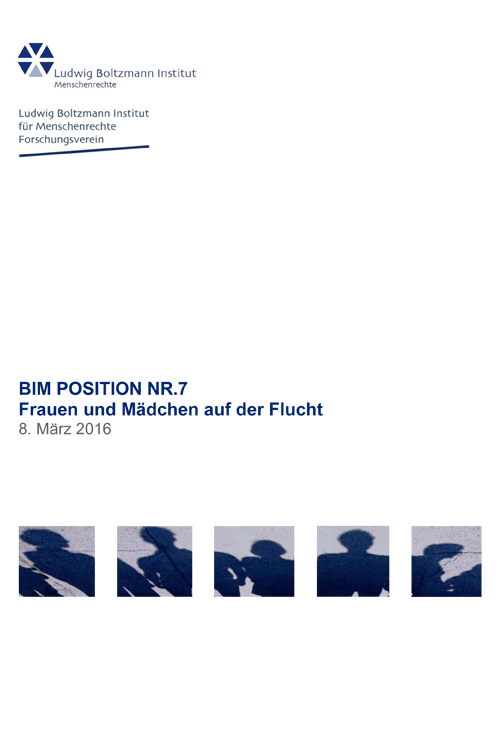BIM Position No 7. | 2016: Women and girls fleeing from their countries
On the occasion of International Women’s Day on the 8th of March 2016, we take a look at the special situation of women and girls, who are exposed to huge risks and distress in various situations on their journey to Europe.
According to the United Nations High Commissioner for Refugees (UNHCR), the proportion of women and children among new arrivals was at 55% in January 2016.[1] Women and girls were often affected by gender-related violence not only on their way to Europe, but also in refugee accommodation in the host countries, at a time, when they thought that they were already safe. Many of them left their countries because of sexual violence or other forms of women’s rights violations. Women from Syria, for example, left their country for fear of being raped and sexually abused. [2]
So far, there is no reliable data on the extent of the gender-related violence which women and girls are experiencing on their escape to Europe. In recent months certain international organisations such as UNHCR, the United Nations Population Fund (UNFPA), the Women Refugees Commission and Amnesty International conducted surveys among refugees and migrants.[3]The first evidence suggests, that sexual violence, rape and domestic violence affected many women, especially those travelling alone. Some cases of forced marriage and early marriage were also documented. Some women reported sexual activities occurring in return for transport and travel documents.”[4] Also in Germany many women in ‘collective living quarters’ in the state of Brandenburg reported domestic violence.”[5]
Most attacks and violations are not registered with the police and in addition the women who fall victim do not tend to use medical aid. The reasons are manifold. Either they do not have accessible information (in their mother tongue and in easily-understandable formats) to which they may turn in the case of gender-based violence, they could be hesitant to talk about it, or indeed they may not want to delay their journey and the journey of their family. The offenders are mostly male refugees, policemen, security guards and smugglers.
As a consequence, most of the women and girls remain silent, as the topic receives little attention at all and political decision makers respond only tentatively.
Accommodation for refugees is often extremely overloaded and community life is difficult. Living in such circumstances– often over several months – fosters gender-related violence. Usually women do not have separate rooms for retreat and they are required to share their accommodation with men – this especially can become a problem, or even a risk for single women and girls. Toilets and washrooms frequently become unsafe places, because they are mostly not separated by sex and the paths to them are often poorly illuminated. The situation for pregnant and breastfeeding women is especially precarious because their provisions of medical and health care are often not guaranteed.
Women´s rights standards and recommendations
The Istanbul Convention[6] and General Recommendation No. 32 of the UN Committee on the Elimination of Discrimination Against Women point out the special need for protection of women and girls in the context of escape and asylum.[7] In a recent statement of the UN Committee they demand the full access of female asylum seekers and refugees to food, accommodation, water, sanitary facilities, health service and education. Furthermore, all states are called upon to create effective measures to protect women and girls from violence.
UNHCR, UNFPA and the Women´s Refugee Commission complain about the absence of a gender-specific perspective in all humanitarian interventions. Furthermore, at a national level there are almost no measures that refer to the special needs of women and girls. Here are some of their recommendations for governments and EU-agencies[8]:
- Setting up coordinated and cross-border systems protecting women and girls
- Carrying out courses and trainings on gender specific violence for police, security guards, staff of institutions, etc.
- In accommodations for refugees: Developing effective mechanisms for the protection and support in case of violence, for example concepts on protection of women against violence , female contact persons in accommodations, full application of violence act (barring order, support through intervention centres, etc.)
- Gender-related persecution has to be taken seriously as a reason for asylum and has to be fully recognised
Further reading:
- Rabe, Heike: Effektiver Schutz vor geschlechtsspezifischer Gewalt auch in Flüchtlingsunterkünften, Deutsches Institut für Menschenrechte, 2015.
- Dokumentation der Tagung: “Frauen in Flüchtlingsunterkünften: Lage erkennen – Rechte wahren“ vom Deutschen Institut für Menschenrechte, Jänner 2016, http://www.institut-fuer-menschenrechte.de/themen/frauenrechte/gewalt-gegen-frauen/fluechtlingsfrauen/
- Guidelines for Integrating Gender-based Violence Interventions in Humanitarian Actions, Inter-Agency Standing Committee, 2015.
- Mean Streets: Identifying and Responding to Urban Refugees‘ Risk of Gender-Based Violence, Women’s Refugee Commission, 2016 (4.3.2016)
[1] Frauen auf der Flucht in Europa bedroht, UNHCR, 20. Jänner 2016, http://www.unhcr.at/home/artikel/897c36a0776bb65148e07a16da5942dc/bericht-warnt-frauen-auf-der-flucht-in-europa-bedroht.html (4.3.2016)
[2] Syrien: Sexuelle Gewalt droht Frauen auch noch auf der Flucht, Amnesty International, 22. November 2013, http://frauenrechte.amnesty.at/allgemein/syrien-sexuelle-gewalt-droht-frauen-auch-noch-auf-der-flucht/ (4.3.2016)
[3] Initial Assessment Report: Protection Risks for Women and Girls in the European Refugee and Migrant Crisis. Greece and the former Yugoslav Republic of Macedonia. UNHCR, UNFPA, Women’s Refugee Commission, 2015. www.unhcr.org/569f8f419.html (4.3.3016) und einer Befragung von Amnesty International in Deutschland und Norwegen: Sexuelle Gewalt und finanzielle Ausbeutung, https://www.amnesty.at/de/frauen-gewalt/, 18.1.2016 (4.3.2016)
[4] Frauen auf der Flucht in Europa bedroht, 2016.
[5] Rabe, Heike: Situation weiblicher Flüchtlinge in den Erstaufnahmeeinrichtungen in Thüringen. Schriftliche Stellungnahme des Deutschen Instituts für Menschenrechte zur öffentlichen Anhörung des Gleichstellungsauschusses des Thüringer Landtages, 2015, http://www.institut-fuer-menschenrechte.de/publikationen/asylflucht/ (4.3.2016)
[6] Übereinkommen des Europarates zur Verhütung und Bekämpfung von Gewalt gegen Frauen und häuslicher Gewalt v. 11. 5. 2011; Österreich hat das Übereinkommen am 14.11.2013 ratifiziert, das im August 2014 in Kraft getreten ist.
[7] General Recommendation No. 32 on the gender-related dimensions of refugee status, asylum, nationality and
statelessness of women, CEDAW/C/GC/32, 14.11.2014.
[8] Initial Assessment Report, 2015, S. 13 ff und Terre des Femmes: Forderungen zur Berücksichtigung der besonderen Schutzbedürftigkeit von Frauen auf der Flucht, https://www.frauenrechte.de/online/index.php/themen-und-aktionen/aktuelles-zu-frauenrechten-allgemein/1888-terre-des-femmes-fordert-besonderen-schutz-fuer-frauen-auf-der-flucht, 21.10.2015 (4.3.2016)
